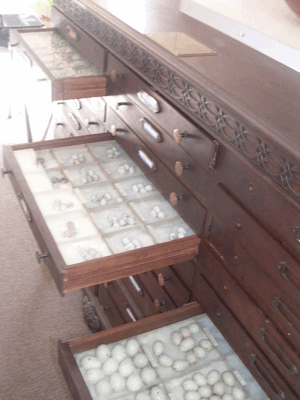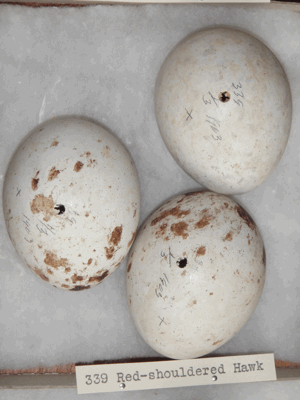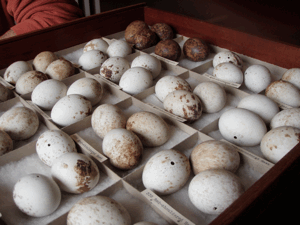Bird Eggs Unhatched
Air Date: Week of August 20, 2010
(Photo: University of Connecticut)
In the 1800’s, a man named Harry Curtiss Mills started a collection. The Connecticut resident amassed and traded thousands of bird eggs, from 840 species. His egg collection was donated to a local library where for decades it was neglected, stored away in a cabinet. Now, Harry Curtiss Mill’s eggs have found a new home in the University of Connecticut’s Biodiversity Research Collections. As producer Laurie Sanders reports, the egg collection provides a unique record of bird life in 19th century Connecticut.
Transcript
YOUNG: When Farmington, Connecticut's Barney Library undertook a major renovation last year, staff decided to get rid of some very fragile stuff - 8,000 birds’ eggs. The egg collection was donated in 1924, and has been stored in a closed cabinet on the library's second floor ever since. The Library donated the egg collection to the University of Connecticut's Biodiversity Research Collections. Producer Laurie Sanders was there on moving day and has our story.
WOMAN: Hey Tanner, don’t forget to dig out the batting from underneath the box, OK?
SANDERS: It’s 9 in the morning, and a small group of grad students and faculty from UCONN has just arrived at the Barney Library in Farmington, Connecticut.
[SOUNDS OF SOMEONE CLIMBING METAL STAIRCASE]
SANDERS: The crew uses a back staircase to reach a second floor meeting room. It’s here inside a special wooden cabinet that an enormous collection of wild bird eggs has sat for decades.
RUBEGA: It’s a beautiful piece of furniture, but it’s really not secure storage from the point of view of modern specimen storage.
SANDERS: Margaret Rubega is Connecticut’s State Ornithologist, and a biologist at UCONN.
RUBEGA: It’s truly stunning the condition this collection is in. It really has survived through benign neglect and the protection of being in an institution like a library.

The Barney Library in Farmington, Connecticut housed this bird egg collection for more than 80 years. They recently donated it to the University of Connecticut’s Museum of Natural History. (Photo: University of Connecticut)
SANDERS: Egg collecting was a wildly popular hobby in the 19th century. But Rubega says this collection is extraordinary.
RUBEGA: It’s a big collection. It’s fully documented, and especially what’s important for us as an institution of the state, is that the vast majority of eggs in this collection come from Connecticut. It’s a physical library of the birds who were in Connecticut in the 19th century. The habitat has changed, the bird life has changed, the conditions under which the birds are trying to make a living and reproduce has changed. It’s just an unbelievable record of what the bird life in this state used to be.
[SOUND OF DRAWER OPENING]
SANDERS: Rubega slides a drawer open. The eggs are beautiful, meticulously organized and labeled. Grackles. Red winged blackbirds. There is a whole drawer full of tiny hummingbird eggs. Several others contain just warbler eggs. In the deeper drawers are the bigger eggs—those of owls, gulls, hawks, falcons, herons. When 19th century collectors took eggs, they didn’t take just one. They took whatever was in the nest. Then they drilled a tiny hole in each egg and removed the yolk and egg white. Rubega opens drawer after drawer. It’s like a treasure chest, filled with glossy white, blue, pale brown, buffy green. Harry Curtiss Mills amassed this collection. He was an electrician, born in the 1860s, and like many people in the late 19th century, he was passionate about natural history. He and his wife had collections of rocks, butterflies, wildflowers, shells. But all of these were surpassed by his collection of bird eggs.

Red-shouldered hawk eggs with penciled set marks, and holes that were drilled to remove the egg contents. (Photo: University of Connecticut)
[SOUNDS OF ROOM, PEOPLE SPEAKING]
SANDERS Over the course of 50 years, Mills collected, traded and bought thousands of eggs, representing 840 species.
[RUBEGA SPEAKING]
SANDERS: Before removing the drawers of eggs from the cabinet, the team goes over how they’ll record the information in a database, and how they’ll move, pack and protect the eggs in their new museum containers.
RUBEGA: So if you look take a close look at this first clutch of eggs, penciled on it, near the hole usually, is the set mark that the field collector would have recorded on the data card. Go ahead gather round and see if you can see the number.
SANDERS: They take a couple photos of the cabinet, and then they take the first real step. They take OUT the first drawer.
[SOUND OF DRAWER OPENING]
SANDERS: And then they take off the glass sheet that’s been covering the eggs for 85 years.
[SOUND OF MOVING GLASS]
RUBEGA: There it is! Let’s take a picture.
SANDERS: The team begins to carefully duplicate the information Harry Curtiss Mills penciled on each egg into a database.
[TYPING ON KEYBOARD]
STUDENT: Set mark is two over four, there are four eggs, species is four 66 A.
SANDERS: Egg collecting became illegal in America in 1918, with the passage of the Migratory Bird Treaty Act. The practice had taken a toll on bird populations, especially some rare species. Rubega says a well-documented, extensive collection like this one now can play a valuable role. It shouldn’t just remain a curiosity shown off in a parlor.
.gif)
Susan Hochgraf, Vertebrate Collections Manager of the Ecology and Evolutionary Biology Research Collections at University of Connecticut, takes a close look at osprey eggs. (Photo: University of Connecticu)
RUBEGA: The scientific value of this collection is sort of easiest to understand if you think about the collection exactly the same way that you think of about the collection of books in a library. In every single one of these eggs, there’s information about what the world was like at the time the egg was collected.
SANDERS: Rubega says collections make it possible for scientists to answer questions they didn’t even know they were going to have—like investigating the impact of acid rain or climate change, or the presence of environmental contaminants. Years ago, old egg collections like this one proved crucial in linking the thinning of eggshells to DDT.
Right now, a graduate student at UCONN is studying the relationship between cadmium levels and declining populations of American woodcock. Rubega says he’s chomping at the bit to analyze these eggs and compare cadmium levels from a century ago to those seen in woodcock eggs today.
STUDENT: Chestnut-sided warbler. On every egg is written 659, and on the group of four eggs is written…
SANDERS: The eggs are now in a collection at UCONN and available to anyone who wants to see them. For Living on Earth, I'm Laurie Sanders.
Links
Living on Earth wants to hear from you!
Living on Earth
62 Calef Highway, Suite 212
Lee, NH 03861
Telephone: 617-287-4121
E-mail: comments@loe.org
Newsletter [Click here]
Donate to Living on Earth!
Living on Earth is an independent media program and relies entirely on contributions from listeners and institutions supporting public service. Please donate now to preserve an independent environmental voice.
NewsletterLiving on Earth offers a weekly delivery of the show's rundown to your mailbox. Sign up for our newsletter today!
 Sailors For The Sea: Be the change you want to sea.
Sailors For The Sea: Be the change you want to sea.
 The Grantham Foundation for the Protection of the Environment: Committed to protecting and improving the health of the global environment.
The Grantham Foundation for the Protection of the Environment: Committed to protecting and improving the health of the global environment.
 Contribute to Living on Earth and receive, as our gift to you, an archival print of one of Mark Seth Lender's extraordinary wildlife photographs. Follow the link to see Mark's current collection of photographs.
Contribute to Living on Earth and receive, as our gift to you, an archival print of one of Mark Seth Lender's extraordinary wildlife photographs. Follow the link to see Mark's current collection of photographs.
 Buy a signed copy of Mark Seth Lender's book Smeagull the Seagull & support Living on Earth
Buy a signed copy of Mark Seth Lender's book Smeagull the Seagull & support Living on Earth


